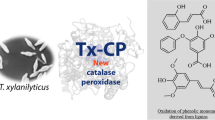Abstract
Three different phenol oxidases produced by the basidiomycete fungus Pleurotus ostreatus have been isolated and their main structural, enzymatic and physico-chemical properties characterized. Studies have forcaused on the most abundantly secreated of these proteins, a copper-e nzyme specific towards ortho-diphenol substrates. This protein was purified to homogeneity and part of its primary structure determined by direct protein sequencing. The ingluence of pH, temperature and presence of water-soluible or water-insoluble organic solvents on the activity and stability of the enzyme were also investigated. These data can be used for applying bioarectors to problems of environmental concern such as waste-water treatment
Similar content being viewed by others
References
Basiani M, Felici M, Luna M, Artemi F (1983) Laccase assay by means of high-performance liquid chromatography. J Anal Biochem 133:275–276
Boman B, Ek M, Eriksson KE, Frostell B (1988) Some aspects on biological treatment of bleached pulp effluents. Nord Pulp Pap Res J 3:13–18
Bourbonnais R, Paice MG (1990) Oxidation of non-phenolic substrates. An expanded role for leaccase in lignin biodegradation. FEBS Lett 267:99–102
Cain RB (1981) Microbiol degradation of surfactants and “builder” compounds. In: Leisinger T, Cook AM, Hutter R, Nuesche J (eds) Microbiol degradation of xenobiotics and recalcitrant compounds. Academic Press, London, pp 325–370
Dom E, Hellwig M, Reineke W, Knackmuss HJ (1974) Isolation and characterization of a 3-chlorobenzoate-degrading Pseudomonas. Aech Microbiol 99:61–70
Eriksson K-EL (1985) Swedish development on biotechnology related to the pulp and paper industry. TAPPI J 68:46–55
Eriksson K-EL, Balnchette RA, Ander P (1990) In: Timell TE (ed) Microbial and enzymatic degradation of wood and wood components. Springer, Berlin, Heidelberg, New York, pp 225–333
Farrell RL, (1987) Industrial applications of lignin-transforming emzymes. Philos Trans R Soc Lond A 321:549–553
Felici M, Artemi L, Luna M, Speranza M (1985) Determination of laccase activity with various aromatic substrate by high-per-formance liquid chromatography. J Chromatogr 320:435–439
Hames BD (1981) An introduction to polyacrylamide gel electrophoresis. In: Hames BD, Rickwood D (eds) Gel electrophorisis of proteins.IRL Press, Washington, D. C., pp 1–86
Harkin JM, Obst JR (1973) Syringaldazine, an effective reagent for detecting laccase and peroxidase in fungi. Experientia 29:381–387
Hunkapillar M, Hood L (1983) Protein sequence analysis: autometed microsequencing. Science 219:650–659
Kawai S, Umezawa L (1983) Degradation mechanisms of phenolic β-1 lignin substrate model compounds by laccase of Cotiolus versicolo. Arch Biochem Biophys 262:99–110
Kawai S, Umezawa T, Shimada M, Higuchi T (1988b) Aromatic ring cleavage of 4,6-di(tert-butyl)guaiacol,a lignin model compound, by leaccase of Coriolus versicolor. FEB Lett 236:309–311
Kirk TK, Shimata M (1985) Lignin biochemistry of dedgradation by white-rot fungi, In: Higuchi T (eds) Biosynthesis and biodegradation of wood components. Academic Press, Orlando 579–605
Kojima Y, Tsukuda Y, Kawai Y, Tsumakamoto A, Suguira Sakaino M, Kita Y (1990) Cloning sequence anlayis and expreessioon of ligninolytic phenoloxidase genes of the white-rot basidiomy-cate Coriolus hirsutus. Biol Chem 265:15224–15230
Kuwahara M, Glenn JK, Moragan MA, Gold MH, (1984) Separation and characterization of two extracellular H2O2-dependent oxidases from ligninolytic cultures of Phanerochaete chrysosporium. FEBS Lett 169:247–250
baLaemmli UK (1970) Cleavage of structuaral proteins durthe assembly of the head of bacteriophage T4. Nature 227:680–685
Morohshi N, Wariishi H, Muraiso C, Nagai T, Haraguchi T (1987) Degradation of lignin by the exracellular enzymes of Corioulus versicolor. IV. Properties of three laccase fractions fractionated from the extracellular enzymes. Mokuzai Gakkishi 33:218–225
Oekley BR, Kirsch DR, Morris NR (1980) A simplified utlrasensitive silver stain for detecting proteins in polyyacrylamide gels. Anal Biochem 105:361–363
Pellinen J, Abuhasen J, Joyce TW, Chang H-m (1989) Biological delignification of pulp by Phanerochaete chrysosporium. J Biotechnol 10:162–170
Roy-Arcnad L, Archibalds FS (1991) Direct dehlorination of chlorophenolic compounds by laccases from Trametes (Coriolus) versicolor. Enzyme Microb Technol 13:194–203
Saloheimo M, Niku-Paavola ML, Knowles JKC (1991) Isolation and structural analysis of tha laccase gene from the lignin-de-grading fungus Phlebia radiata. J Gen Microbiol 137:1537–1544
Sannia G, Giardina P, Luna M, Rossi M, Buonocore V (1986) Laccase form Pleurotus osreatus. Biotechnical Lett 8:797–800
Sannia G, Limongi P, Cocca E, Buonocore F, Nitti G, Giardiana P (1991) Purefication and charcterization of a veratryl alcohol oxidase enzyme from the lignin degrading basidiomycete fungus Pleurotus oqtreatus. Biochim Biophys Acta 1073:114–119
Setliff EC, Eudy WW (1980) Screening white-rot fungi for their capacity to delignify wood. In: Kirk TK, Higuchi TChang H-M (eds) Lignin biiodegradation: microbiology, chemistry and potential applications, vol 1. CRC, Boca Raton, pp 135–149
Tein M, Krik TK (1984) Lignin-degrading enzyme from Phanerochaete chrysosporium: purification, characterization and catalytic properties of a unique H2O2-requiring oxygenase. Proc Natl Acad Sci USA 81:2280–2284
Valli K, Gold MH (1991) Degradatioon of 2,4-dichlorophenol by the lignin-degrading fungus Phanerochaete chrysosporium. J Bacteriol 173:345–352
Wolfenden BS, Willson RL (1982) Radical cations as reactions: pulse radiolysis studies of 2,2’-azino-bis(3-ethylbenz-thiazolilne-6-sulphonate). J Chem soc Perkin Trans 2:805–812
Author information
Authors and Affiliations
Additional information
Correspondens to: G. Sannia
Rights and permissions
About this article
Cite this article
Palmeiri, G., Giardina, P., Marzullo, L. et al. Stability and activity of a phenol oxidase from the ligninolytic fungus Pleurotus ostreatus . Appl Microbiol Biotechnol 39, 632–636 (1993). https://doi.org/10.1007/BF00205066
Received:
Accepted:
Issue Date:
DOI: https://doi.org/10.1007/BF00205066




